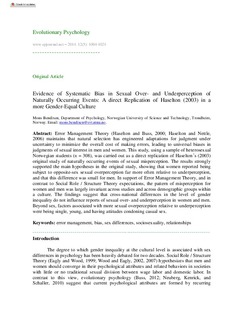| dc.contributor.author | Bendixen, Mons | |
| dc.date.accessioned | 2019-11-07T06:45:21Z | |
| dc.date.available | 2019-11-07T06:45:21Z | |
| dc.date.created | 2014-11-18T10:20:02Z | |
| dc.date.issued | 2014 | |
| dc.identifier.citation | Evolutionary Psychology. 2014, 12 (5), 1004-1021. | nb_NO |
| dc.identifier.issn | 1474-7049 | |
| dc.identifier.uri | http://hdl.handle.net/11250/2627053 | |
| dc.description.abstract | Error Management Theory (Haselton and Buss, 2000; Haselton and Nettle, 2006) maintains that natural selection has engineered adaptations for judgment under uncertainty to minimize the overall cost of making errors, leading to universal biases in judgments of sexual interest in men and women. This study, using a sample of heterosexual Norwegian students (n = 308), was carried out as a direct replication of Haselton's (2003) original study of naturally occurring events of sexual misperception. The results strongly supported the main hypotheses in the original study, showing that women reported being subject to opposite-sex sexual overperception far more often relative to underperception, and that this difference was small for men. In support of Error Management Theory, and in contrast to Social Role / Structure Theory expectations, the pattern of misperception for women and men was largely invariant across studies and across demographic groups within a culture. The findings suggest that cross-national differences in the level of gender inequality do not influence reports of sexual over- and underperception in women and men. Beyond sex, factors associated with more sexual overperception relative to underperception were being single, young, and having attitudes condoning casual sex. | nb_NO |
| dc.language.iso | eng | nb_NO |
| dc.publisher | Sage Publications | nb_NO |
| dc.relation.uri | https://journals.sagepub.com/doi/abs/10.1177/147470491401200510 | |
| dc.rights | Navngivelse-Ikkekommersiell 4.0 Internasjonal | * |
| dc.rights.uri | http://creativecommons.org/licenses/by-nc/4.0/deed.no | * |
| dc.title | Evidence of systematic bias in sexual over- and underperception of naturally occurring events: A direct replication of Haselton (2003) in a more gender-equal culture | nb_NO |
| dc.type | Journal article | nb_NO |
| dc.type | Peer reviewed | nb_NO |
| dc.description.version | publishedVersion | nb_NO |
| dc.source.pagenumber | 1004-1021 | nb_NO |
| dc.source.volume | 12 | nb_NO |
| dc.source.journal | Evolutionary Psychology | nb_NO |
| dc.source.issue | 5 | nb_NO |
| dc.identifier.doi | 10.1177/147470491401200510 | |
| dc.identifier.cristin | 1174004 | |
| dc.description.localcode | Open Access CC-BY-NC | nb_NO |
| cristin.unitcode | 194,67,40,0 | |
| cristin.unitname | Institutt for psykologi | |
| cristin.ispublished | true | |
| cristin.fulltext | original | |
| cristin.qualitycode | 1 | |

